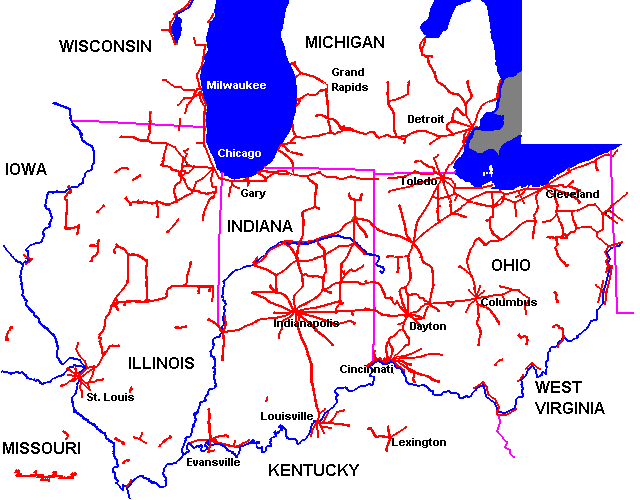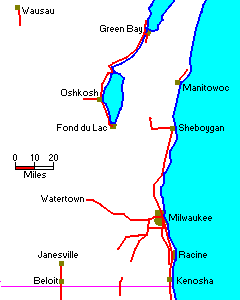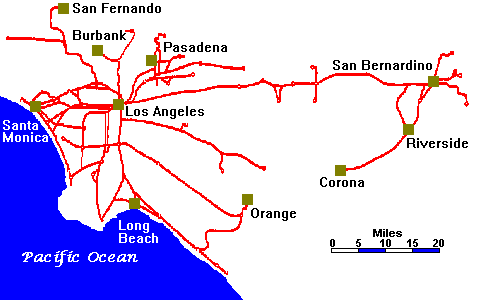The Consumer Society
Steven Dutch, Professor Emeritus, Natural and Applied Sciences, Universityof Wisconsin - Green Bay
Suburbia
Almost as soon as there were cities, there were people who wanted to escape them. Theideal, being close enough to the city to enjoy its advantages while being away from itscrowding, usually was limited to the wealthy, who were not inconvenienced by the cost andtime involved in traveling in and out. Cities tended to be small and densely packed sincepeople went almost everywhere on foot. Mechanized transport changed all that.
Ferryboats made it possible for suburbs to spring up in a few places, mostly around NewYork City, which is ideally suited to water transport. Brooklyn began to grow when itbecame a ferryboat suburb, as did a number of towns along the lower Hudson and in NewJersey. To this day, the Staten Island Ferry is a revered feature of New York life. Butferryboats are slow and have limited capacity, so ferryboat suburbs were few. Suburbsbegan to proliferate with the coming of the railroad. The term commuter firstappears in 1865. But even with the railroad, suburbs tended to be small and populated bythe affluent.
Streetcars and interurban rail lines made it possible for suburbs to expand enormously.The United States once had the largest network of urban and interurban railways in theworld. The map below shows the system that once existed in the Midwest (note: the map isincomplete - it shows electric rail lines only)
 | This is the interurban system that once existed in Wisconsin (there was also a short line between Eau Claire and Chippewa Falls). The Fox Valley and lakeshore systems do not connect because you would not have gone from Green Bay to Milwaukee by interurban - there were regular trains for that purpose. These trains served purely local needs only. |
It was once possible to go from the Atlantic coast to the Rocky Mountains on interurbanrail lines, with only a few gaps in the West. In 1900 Berlin had the largest streetcarsystem in Europe, but twenty American cities had more extensive systems. By 1902 NewYork's streetcars were carrying a billion passengers a year and the terms rush hourand traffic jam had appeared. The largest system, amazing as it seems, was that ofLos Angeles. Los Angeles doesn't sprawl because of freeways; Los Angeles has freewaysbecause it sprawls. The urban sprawl was actually created by the streetcar.
 | The interurban system that once served southern California. |
 | The animated-live action film Who Framed Roger Rabbit? revolves around a crazy plan to build something called a "freeway" in Los Angeles. Early in the film, the human hero scoffs "Who needs a car in Los Angeles? We have the finest public transportation in the world." Between the interurban network and the streetcar lines (at left), he wasn't far off the mark. |
Don't get the impression the streetcar era was an idyllic time free of corporatecorruption. Far from it. More often than not, streetcar lines also owned real estate andtended to extend lines into areas where they wanted to sell real estate, while bypassingareas owned by competitors.
Streetcars were eventually done in by a cartel of oil and rubber companies and GeneralMotors, who bought up and shut down streetcar systems in over 100 cities, not, as popularmyth has it, to sell cars, but to sell buses, which were first called tracklesstrolleys. Streetcar lines, despite their heavy use, generated negligible profits.Buses have substantial advantages over streetcars: they require no tracks or electriclines and can be rerouted easily (This latter "advantage" is doubtful; given achoice between light rail, which is fixed, and buses, which travel convoluted routes, I'lltake rail every time.). Buses are better suited to small passenger loads, and in the lighttraffic before World War II, were probably faster than trolleys. The cartel was eventuallytaken to court and given a token fine, but by that time the trolley systems were largelydismantled.
The First High-Tech War
I am convinced that historians of the future will se World War II as a tremendoustechnological and cultural watershed. Films like The Sting or TV shows like TheWaltons set in the 1930's have a quaint and foreign feel to them. They're almost asremote as stories about Elizabethan England. One of the things that makes the IndianaJones films fun is that Indiana Jones is essentially a late 20th century person inattitude raising havoc in an era he really isn't part of. On the other hand, films set inWorld War II, even those made at the time, have a distinctly modern look and feel.
If the Civil War was the first modern war, in whichtechnology was a crucial element, World War II was the first high-tech war, in whichmilitary supremacy depended on innovations made during the war itself. Never before didthe outcome of a war depend so much on weapons that didn't even exist in practical formwhen the war began. Some of the innovations that appeared during the war (again, as withthe Civil War, some existed in prototype form earlier) were:
- Computers
- Radar
- Jet Aircraft
- Missiles
- Nuclear Weapons
Jet Aircraft, missiles, and nuclear weapons all appeared late in the war. Jet aircraftand missiles did not appear in numbers sufficient to affect the outcome, but the designsof many of the early missiles were surprisingly sophisticated. Although we think of cruisemissiles as modern, the very first cruise missile was actually the German V-1, and otherswere being tested by the U.S. Britain and Germany when the war ended. Had World War IIlasted a few years longer, it might well have evolved into a very modern war indeed,fought with jets, cruise missiles, and nuclear weapons.
The most interesting military technology of World War II is the one that wasn't used -chemical warfare. So-called blister agents like mustard gas were known in World WarI and nerve agents were discovered in the 1930's as a byproduct of research oninsecticides (many insecticides are nerve gas for insects; some of the stronger onesproduce positive responses on chemical detectors and are actually used in training inchemical detection in the military). The British had decided to use chemical weapons as alast resort if they were invaded, but none of the belligerents actually used them (exceptfor some uses by the Japanese in China). The overall impression is that the non-use ofchemical weapons in World War II was a very near thing.
The Post-War Era
Technology, Needs, and Wants
The Need Hierarchy
The psychologist Maslow developed his famous need hierarchy, which arrangeshuman needs and drives in order of priority:
- Survival
- Comfort
- Self-Esteem
There are, of course, many individual variations. Some people will sacrifice comfortand perhaps even survival for self-esteem. In some cases the self-esteem may be a matterof preserving social status (risking death rather than appearing cowardly orenduring an insult, for example),in other cases adherence to some code of ethics (for example, risking death to protectvictims of genocide). On the whole, though, most people tend to sacrifice self-esteem forcomfort and comfort for survival. Exceptions tend to occur when needs higher on the scaleare met in abundance; it's more common for relief workers to give up a meal to helpsomeone than for concentration camp inmates.
Refugee situations illustrate the need hierarchy in action. Workers with aidorganizations often make conservative welfare reformers look soft in comparison; they areadamant in insisting that refugee relief provide for survival, but not comfort. It is nothard for Western relief efforts to provide standards of living so far beyond thosenormally found in some parts of the world that refugees are actually discouraged fromreturning home. As one aid worker remarked to me in Kurdistan, "it's amazing hownasty you sometimes have to be to people to help them."
In a perverse way, the emergence of human cantankerousness in disasters and refugeesituations is a good sign. It means that people are sufficiently confident of survivalthat they can begin worrying about comfort and self-esteem again. It means thelife-threatening crisis is largely over.
Technology is the key to satisfying the first two levels. It doesn't take muchtechnology to assure survival under reasonably benign conditions, or even quite harsh ones- the Inuit figured out how to survive in the Arctic thousands of years ago. Comfort takesa bit longer, although American society is already in some ways too comfortable for itsown good and even the worst American slum offers amenities like electricity, indoorsanitation and running water that would have been considered fabulous luxuries by thestandards of ages past. Indeed, having visited several places that have catapulted fromsevere poverty to relative affluence in a single human lifetime, it is hard in suchsettings to see technology as anything but an unmixed blessing.
It's when technology is applied to the quest for self-esteem that many of the realproblems associated with technology arise. The quest for self-esteem often expressesitself in a drive for power, control, or supremacy over others, often with technology usedas the implement for attaining it. A great deal of the inequality in the worldis due to the quest for status rather than any real scarcity. A Middle Easternsaying goes "It is not enough for me to succeed - my enemies must alsofail." A society driven by this value system will never achieve plenty forall, regardless of how abundant the resources are, because status not only meansacquiring resources but also denying them to others. Since the powerful can confer status or the means to attain it on others, they can luretechnologists away from the solution of socially pressing problems into less productiveefforts.
Since nobody ever attains perfect self-esteem, there are endless games one can playwith peoples' minds. Technology is commonly used to stimulate insecurities, jealousies,and appetites, or to promise fulfillment with the latest gadget. With the latest car youare promised acceptance, status, sex appeal, and at no extra cost, a means oftransportation, too.
The problem with the solutions
Critics of modern technology often propose solutions that make the problems worseinstead of better, usually because they see the problems as technological. Oneapproach is the Marxist approach of doing away with economic inequality by variousrestructurings of the system. The fallacy of this approach was easily apparent in theshort-lived game Anti-Monopoly, which was pulled off the market after ParkerBrothers sued for copyright infringement. Although the game's backers saw the suit assimply another example of corporate power, the game really was a flagrant knock-off of Monopoly,except that winners accumulated "social consciousness" points rather than money.And therein lies the lesson: power and privilege is the name of the game, notmoney. If money is the route to power and privilege in a society, people will pursuemoney. If not, they will pursue whatever is. In Anti-Monopoly it was"social consciousness" points. In the former Soviet Union it was connections andParty position; the privileged group, the nomeklatura was not wealthy intraditional economic terms, but they enjoyed the lifestyle of the wealthy. As HenryKissinger once noted, "power is the ultimate aphrodisiac."
In extreme cases, economic reformers have called for the abolition of money itself.This experiment was literally carried out by the Khmer Rouge of Cambodia; Cambodia becamethe only nation in modern history to abolish money. It also saw a bloodbath (chronicledfor all time in the film The Killing Fields) in which perhaps a third of thecountry's population died. The proposition that money is the root of all evil could hardlybe more graphically disproven.
So what is the solution? I see it as threefold:
- Since power and privilege are the name of the game, use them to reward socially beneficial behavior. This also means denying power and privilege to the socially irresponsible. For example, it doesn't matter how well you can dunk; commit a crime and you're out of sports forever.
- Be aware that there are always people who want rewards without paying the price, and be on guard against them.
- Abandon the dream that there is a system that can be put in place after which everyone can sit back and relax. Every system can be perverted, and sooner or later (usually sooner) the people who want rewards for nothing will find the way. The system will always have to be guarded and updated. Eternal vigilance is the price of everything.
Blue Blood and Red Necks: Technology, Status and Sex Appeal
A lot of research has gone into understanding what constitutes attractiveness indifferent cultures. Some features seem to be universal; there are no known cultures inwhich the signs of aging are considered physically attractive, for example. It's wellknown that women tend to see attractiveness in different terms than men. Men tend toconcentrate on physical attributes, which signify reproductive capacity andavailability. Women, who both biologically and culturally tend to beburdened with child-rearing, often tend to value attributes that relate to ability toprovide for and protect a family.
What does this have to do with technology? Perceived attractiveness is often linked tothe attributes below, which are often linked to technology. These are allclosely interrelated attributes.
- Status
- Attractiveness is often closely linked to status, which in turn may be closely linked to technological factors like ownership of resources, leisure, or occupation.
- Command of Resources
- In need-driven societies, command of resources is closely linked to the perceived ability to support and protect a family. In affluent societies, command of resources means the ability to provide a comfortable, desirable lifestyle. Obviously command of resources is intimately linked to technology.
- Willingness to Invest Resources
- Here's where Madison Avenue makes its bucks. Any car will get you from point A to point B, but the flashy model shows you have the resources and are willing to spend money to show it.
- Desirable Occupation
- These typically are occupations that are seen as exciting, pay a lot of money, involve side benefits like travel, or involve command over others.
- Leisure
- Abundant resources mean extensive leisure time, ability to pay others to deal with mundane problems, and the means to indulge in expensive activities like exotic travel.
Very often the attributes that a time or culture consider attractive relate to theavailability of resources, which in turn is related directly to technology. One of themost variable attributes of beauty is body proportion. Cultures dominated by scarcity tendto value heavy body styles whereas cultures dominated by abundance tend to valueslenderness. In cultures dominated by scarcity, thinness connotes poor nutrition andperhaps chronic disease, but heaviness connotes health and perhaps as importantly, abilityto procure sufficient food. In abundance cultures, where freedom from hunger and diseaseis taken largely for granted, attractiveness often revolves around status, which in turnrevolves around access to resources.
It is only recently that even our own society has achieved real abundance. Until wellinto the 20th century, undernourishment was a significant problem in the United States.The military, which now has standards for excessive weight, was concerned in World War IIabout recruits who were underweight. Milk and eggs, now widely criticizedas sources of fat and cholesterol, were considered excellent sources of vitalnutrients a few decades ago.
As technology changes, the rules of attractiveness also change. Some of theimportant patterns..
- How much resources do you command? This can be demonstrated by possessions, or by lifestyle, such as not having to work or being able to indulge in expensive activities.
- How much effort are you willing to spend? Some people value status so much they will take severe financial risks to buy it; others with more resources will spend less.
The expression "blue blood" is not hard to understand. Look at your wrists.Note the blue appearance of the veins. "Blue blood" once meant that a person wasso insulated from the need to work outdoors that the skin was pallid enough for the veinsto show. To enhance the effect, women sometimes resorted to various white lead compounds.These had the advantage, if you can call it that, of giving the skin a permanent palloreventually. At the opposite pole of status, a "redneck" was somebody who had towork outdoors, becoming chronically sunburned in the process. (The term was once highlypejorative, but with entertainers like Jeff Foxworthy using the term, it has lost much ofits force.)
With the urbanization of America, the proliferation of sedentary jobs, and the growthof leisure time, the emphasis on attractiveness began to change. Sun tans began to be seenas attractive and healthy; they signified enough leisure to spend time outdoors.
Demolition Derbies
Most people have seen films of head-on train collisions. Ever wonder why there happenedto be a movie camera right at the site of a train wreck? The story is an amusing sidelighton America's love affair with the machine.
Locomotives wear out and have to be scrapped. In 1896, the appropriately-named WilliamCrush, vice president of the Missouri, Kansas and Texas Railroad, came up with a moreentertaining and lucrative way of disposing of old locomotives - charge people admissionto see a head-on collision. Unfortunately, he underestimated the power of the explosionwhen the boilers burst. Two spectators were killed, many injured, and the railroad was inlitigation for years. Never again would a railroad stage a train wreck.
Watching the event was farmer Joseph Connolly, who saw a potential for a tremendousspectacle if it was done properly. He plowed most of his savings into the attempt andsubmitted his idea to the Iowa State Fair, who at first were horrified and turned himdown. Connolly finally prevailed by assuming all the risks and liability. The event drew35,000 spectators and was a complete success. From that day on, Connolly was known as"Head-on Joe." Over the years, his wrecks got more spectacular; he took todousing railroad cars with kerosene to make a more spectacular crash. His last wreck wasin 1932, involving two locomotives nicknamed "Hoover" and "Roosevelt."In 36 years he staged 73 wrecks using, predictably, 146 locomotives. He earned over amillion dollars, had millions of spectators, and not a single spectator injury.
Automobiles can be recycled creatively, as well. A local variation, popular in the1920's and 1930's, was driving them off the top of High Cliff near Lake Winnebago.
Return to Course Syllabus
Return to Course Notes Index
Return to Professor Dutch's Home Page
Created 18 September 1998, Last Update 2 December 1998